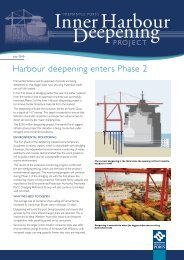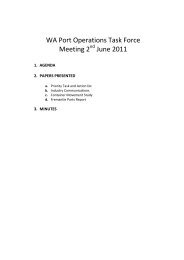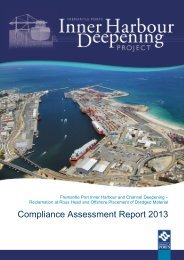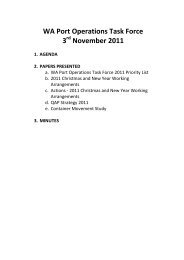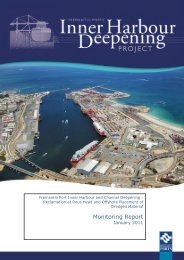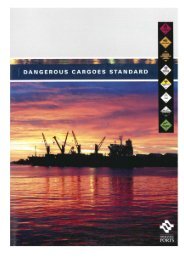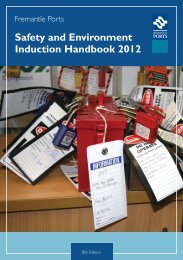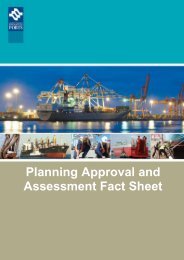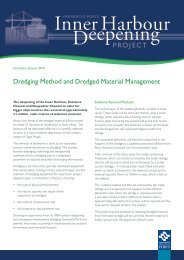Fremantle Port Inner Harbour and Channel ... - Fremantle Ports
Fremantle Port Inner Harbour and Channel ... - Fremantle Ports
Fremantle Port Inner Harbour and Channel ... - Fremantle Ports
- No tags were found...
You also want an ePaper? Increase the reach of your titles
YUMPU automatically turns print PDFs into web optimized ePapers that Google loves.
MethodsInputsThe choice of suitable archive imagery was difficult <strong>and</strong> limited given the availability of cloud freearchive imagery in combination with unknown turbidity levels <strong>and</strong> depths in the water column, whichcould only be assessed once imagery had been acquired over the AOI.After assessment, certain areas of the WV-2 imagery were deemed unsuitable for substrate mappingdue to high turbidity levels <strong>and</strong> significant water depths. An archive GE-1 4-b<strong>and</strong> image, captured on5th December 2011, was additionally acquired over the northern part of the study site to supplementthe 8-b<strong>and</strong> WV-2 imagery. While only available for a portion of the overall study site, the GE-1 imagewas deemed more suitable for mapping substrates due to less interference by sun glint, turbidity <strong>and</strong>wave conditions.The two image sources were used to complete this project where WV-2 data was used for thesouthern part of the Analysis AOI, while GE-1 was used for the northern part of the Analysis AOI(Figure 1). Due to the difference in spectral b<strong>and</strong>s, spatial resolution, capture angles <strong>and</strong> imagedates, the WV-2 <strong>and</strong> GE-1 images were processed separately. Image details <strong>and</strong> specifications arecontained in Table 1.Table 1: Overview of Image inputs <strong>and</strong> their specificationsImage Source Capture Dates Area ResolutionWorldView-2 25th December 2011 27 sqkm 2m multispectralGeoEye-1 5th December 2011 25 sqkm 2m multispectralField data was also provided by Oceanica Consulting which included transect information onsubstrates <strong>and</strong> sea-floor cover (point based) <strong>and</strong> an extrapolated broad scale habitat map(raster/polygon based). This data was used as input to inform the classification.Image ProcessingGeoimage prepared the imagery for analysis using st<strong>and</strong>ard image processing tools.Sun glint reduction was performed on both WV-2 <strong>and</strong> GE-1 multispectral images using an algorithmutilising information from the Near Infrared b<strong>and</strong>s.Upon completion of the sun glint reduction process, the data was clipped to the Analysis AOI basedon Figure 1 where GE-1 data took precedence over the WV-2 data. The clipped areas were uploadedinto a Geographic Object-Based Image Analysis (GEOBIA) environment for individual assessment.Data integration <strong>and</strong> classificationThe delivery of this project was divided into two parts, as specified in Geoimage’s product <strong>and</strong>services quote, with Project 2 dependent on the outcomes of the preceding Project 1. Both projectswere completed using a combination of the spectral characteristics of the WV-2 <strong>and</strong> GE-1multispectral imagery along with manual assignment of marine substrate classes based on trainingdata, which consisted of georeferenced point-based locations <strong>and</strong> type of substrates as defined in thesupplied field data.Due to the possibility of spatial <strong>and</strong> temporal shifts inherent between the acquisition of the imagery<strong>and</strong> field data, as well as the potential refraction within the water column, the field data was used asan approximate indicator of the existence of certain substrates at a given location.Specialists in Satellite Imagery <strong>and</strong> Geospatial Solutions | Commercial in confidence Page | 5



